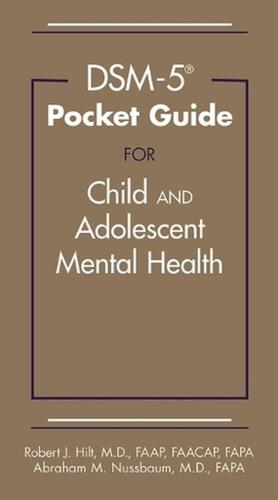Pocket Guide For Child & Adolescent Mental ...
| Item Information | |
|---|---|
| Item#: | 9781615375462 |
| Author | Hilt & Nussbaum |
The Diagnostic and Statistical Manual of Mental Disorders, Fifth Edition, Text Revision (DSM-5-TR) provides an incredibly useful evidence-based, consensus-driven framework for diagnosing mental illness in individuals. When working with children and adolescents, it is insufficient to match the exhibited mental distress to a classification in DSM-5-TR; great care must be given to understanding the cultural, family, gender/sex, and other factors impacting a child's mental health today.
That is what makes the DSM-5-TR Pocket Guide for Child and Adolescent Mental Health so necessary: it serves as a pragmatic translation of DSM-5-TR to clinical practice to provide the most effective treatment. The diagnostic interview remains the focus of this volume, but the information has been updated to reflect the changes in DSM-5-TR. Readers of all skill levels and experience will find practical guidance for 15-, 30-, and 45-minute versions of the interview. The medication tables have also been updated to reflect current evidence. The book also features new sections with chapters describing
• Developing a therapeutic alliance• Meeting a young person experiencing mental distress• Crisis care for a young person• Positive psychology interviews
Drawing on a decade of clinical research and community practice, this pocket guide offers a person-centered approach to care that is relevant in multiple settings-which is particularly useful when considering that young people are more likely to receive an initial mental health diagnosis and treatment in a non–behavioral health setting.
With short, easily referenced chapters and immediately actionable information, the DSM-5-TR Pocket Guide for Child and Adolescent Mental Health is an indispensable companion for the student, trainee, and seasoned clinician alike.
This pocket guide serves as a pragmatic translation of DSM-5-TR to working with children and adolescents. Taking a person-centered approach that is relevant to work in multiple settings, it offers practical guidance for carrying out 15-, 30-, and 45-minute diagnostic interviews.
PrefaceSECTION I: MEETING, DIAGNOSING, AND TREATING CHILDREN AND ADOLESCENTSChapter 1. Starting Out with A Therapeutic AllianceChapter 2. Meeting a Young Person Experiencing Mental DistressChapter 3. Engaging a Young Person Experiencing a Mental Health CrisisChapter 4. Working Together on Common Clinical ConcernsChapter 5. Reaching a DSM-5-TR Diagnosis When You Have 15 MinutesChapter 6. Reaching a DSM-5-TR Diagnosis When You Have 30 MinutesSECTION II: ENGAGING CHILDREN AND ADOLESCENTS WITH DSM-5-TRChapter 7. Reaching a DSM-5-TR Diagnosis When You Have 45 Minutes or More Chapter 8. Recalling Common DSM-5-TR Diagnoses Through TablesChapter 9. Taking Six-Steps to a Differential DiagnosisChapter 10. Organizing a Comprehensive Pediatric Mental Status Examination with a Psychiatric GlossarySECTION III: ADDITIONAL TOOLS AND CLINICAL GUIDANCEChapter 11. Using DSM-5-TR Assessment Measures to Aid DiagnosisChapter 12. Employing Rates Scales and Alternative Diagnostic Systems while Assessing a Young PersonChapter 13. Recognizing Developmental Red FlagsChapter 14. Crafting Pediatric Mental Health Treatment PlansChapter 15. Initiating Psychosocial InterventionsChapter 16. Starting a PsychotherapyChapter 17. Initiating Medications and Monitoring for Adverse Effects Chapter 18. Advancing Mental Health Care for Young People Through Practice, Education, Research, and AdvocacyReferencesIndex

